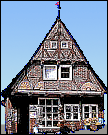|
Drempels un Tegels vun’t Neddersassische
(Nedderdüütsche, Plattdüütsche) Building Blocks of Low Saxon (Low German) Nouns: Number |
There are two nominal numbers: singular and plural. Nouns denoting countable objects may have plural forms.
Plural forms are not very predictable and must be learned with each noun. Below are a few examples.
| Phonemic | Singular | Plural | |||
| Unchanged: | /šaap/ | Schaap | Schaap | 'sheep' | |
| /haar/ | Haar | Haar | 'hair' | ||
| /fiš/ | Fisch | Fisch | 'fish(es)' | ||
| /nööt/ | Nœt | Nœt | 'nut(s)' | ||
| Adding -(e)n | /barg/ | Barg | Bargen | 'mountain(s)', 'hill(s)' | |
| /neeze/ > /neeez/ | Nees’ | Nesen | 'nose(s)' | * | |
| /šoul/ | School | Scholen | 'school(s)' | ||
| Adding -er | /bild/ | Bild | Biller | 'picture(s)' | |
| /kind/ | Kind | Kinner | 'child(ren)' | ||
| /viiv/ | Wief | Wiever | 'woman' > 'women' | ||
| Adding -s | /arm/ | Arm | Arms | 'arm(s)' | |
| /gaarn/ | Gaarn | Gaarns | 'garden(s)' | ||
| /deirn/ | Deern | Deerns | 'girl(s)', 'daughter(s)' | ||
| /küsen/ | Küssen | Küssens | 'cushion(s)', 'pillow(s)' | ||
| Vowel Lengthening: | /šip/ | Schipp | Scheep | 'ship(s)' | |
| Umlauting (alone or in addition): | /boum/ | Boom | Bööm | 'tree(s)' | |
| /droum/ | Droom | Drööm | 'dream(s)' | ||
| /bouk/ | Book | Böker | 'book(s)' | ||
| /mund/ | Mund | Münner | 'mouth(s)' | ||
| Superlength:* | /dag/ | Dag | Daag’ | 'day(s)' | * |
| /bruud/ | Bruut | Brüüd’ | 'bride(s)' | * | |
| /veg/ | Weg | Weeg’ | 'way(s)' | * | |
| /huuz/ | Huus | Hüüs’ | 'house(s)' | * | |
| /deiv/ | Deef | Deev’ | 'thief' | * | |
| /hov/ | Hoff | Hœv’ | 'courtyard(s)', farms | * |
